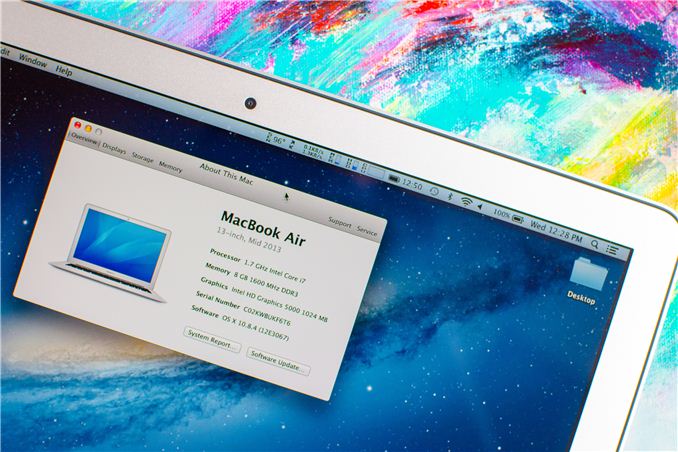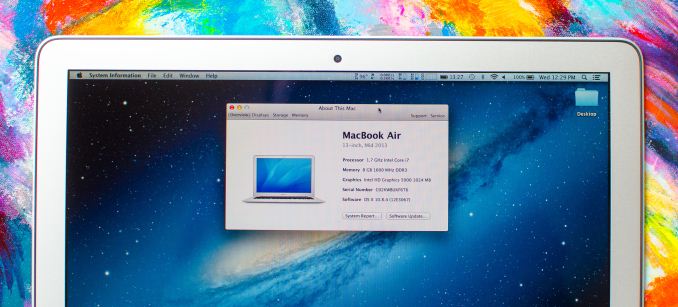The 2013 MacBook Air: Core i5-4250U vs. Core i7-4650U
by Anand Lal Shimpi on July 4, 2013 8:00 AM EST
Apple typically offers three different CPU upgrades in its portable Macs: the base CPU, one that comes with the upgraded SKU and a third BTO option that's even faster. In the case of the 2013 MacBook Air, Apple only offered two: a standard SKU (Core i5-4250U) and a BTO-only upgrade (Core i7-4650U). As we found in our initial review of the 2013 MacBook Air, the default Core i5 option ranged between substantially slower than last year's model to a hair quicker. The explanation was simple: with a lower base clock (1.3GHz), a lower TDP (15W vs. 17W) and more components sharing that TDP (CPU/GPU/PCH vs. just CPU/GPU), the default Core i5 CPU couldn't always keep up with last year's CPU.
For most users upgrading from an older machine the regression won't matter. The 2013 MBA includes a much faster SSD, better graphics, and better CPU performance compared to older MBAs as well. For those users who are either trying to make an ultraportable more of a workhorse, or who otherwise need more performance than last year's MBA can offer there is one solution. The BTO upgrade increases the base clock to 1.7GHz, adds an extra 1MB of L3 cache and includes much higher turbo frequencies:
| Apple 2013 MacBook Air CPU Comparison | |||||
| 1.3GHz dual-core | 1.7GHz dual-core | ||||
| Standard On | 11 & 13-inch MBA | Optional on Both | |||
| Intel Model | Core i5-4250U | Core i7-4650U | |||
| Base Clock Speed | 1.3GHz | 1.7GHz | |||
| Max SC Turbo | 2.6GHz | 3.3GHz | |||
| Max DC Turbo | 2.3GHz | 2.9GHz | |||
| L3 Cache | 3MB | 4MB | |||
| TSX-NI | No | Yes | |||
| TXT | No | Yes | |||
| AES-NI | Yes | Yes | |||
| VT-x/VT-x EPT | Yes | Yes | |||
| VT-d | Yes | Yes | |||
| TDP | 15W | 15W | |||
| Processor Graphics | Intel HD 5000 | Intel HD 5000 | |||
| GPU Clock (Base/Max) | 200/1000MHz | 200/1100MHz | |||
Careful binning makes all of this possible within the same TDP and cooling solution as the standard configuration.
The CPU upgrade comes at a fairly reasonable cost: $150 regardless of configuration. The max clocks increase by almost 30%, as does the size of the L3 cache. The obvious questions are how all of this impacts performance, battery life and thermals. Finally equipped with a 13-inch MBA with the i7-4650U upgrade, I can now answer those questions. The two systems are configured almost identically, although the i7-4650U configuration includes 8GB of memory instead of 4GB. Thankfully none of my tests show substantial scaling with memory capacity beyond 4GB so that shouldn't be a huge deal. Both SSDs are the same Samsung PCIe based solution. Let's start with performance.











127 Comments
View All Comments
FwFred - Saturday, July 6, 2013 - link
OP also called the MBA a coffee shop computer. While it certainly excels at this, it is in no way limited to this.KitsuneKnight - Friday, July 5, 2013 - link
Underpowered? I don't have the 2013 Air, but the base 13" 2011 model, and it's certainly not underpowered by any stretch of the imagination.It makes a wonderful development machine. I regularly run Xcode (+ iOS Simulator), Netbeans, and Visual Studio Premium 2012 (in a Windows 8 VM)*. None of which have a significant impact on battery life (even Visual Studio + Windows 8, which I definitely didn't expect), either. If you want a very light computer for software development, the Air is a wonderful machine.
The only things that actually "kills" battery life are OpenGL games (usually knocking it down to 2-3 hours, from 7). The machine DOES have a good enough GPU to play some indie titles like Minecraft and Kerbel Space Program comfortably, but I'd never recommend an Air as a gaming machine.
* In addition to any of those, I also always have open Safari, Chrome, Spotify, Skype, and iTerm 2 + SSH. Occasionally also Photoshop CS5 (I'm not an artist, though).
ASEdouard - Friday, July 5, 2013 - link
The 2013 Air surprised me as a, of course light, gaming machine. Granted it's not a new game, but I'm playing Starcraft 2 on high details at an excellent framerate. Pretty fun.KitsuneKnight - Saturday, July 6, 2013 - link
That reminds me, I actually have Starcraft 2 installed on this MBA. I have to run it fairly near the minimum settings (at the native resolution) to get decent (not amazing) framerates. If the new model is running SC2 at high with rather good FPS, then it's could probably comfortably play many more games than I'd have guessed.Of course, with how the typical Windows notebook is spec'ed, they'd likely be no better anyways (shipping garbage GPUs is something every OEM seems to loves to do).
ananduser - Saturday, July 6, 2013 - link
The budget shopper, you know, the one the OP made a reference to, has plenty of other better choices that provide more bang for the buck and less profit margin for Apple. The fanboy in you got way to defensive too fast without actually reading my previous post. The budget user won't spend 1000$ on a cramped machine(11") that needs adapters and expensive software licenses -VMWare/Parallels + Windows 8.I will make one concession - those better options are not as light and as portable as the 1000$ 11" MBA but they're still plenty portable.
KitsuneKnight - Saturday, July 6, 2013 - link
If you're wanting something that's super light and portable, the MacBook Air _IS_ the budget option. You would be very hard pressed to find a machine that trumps its portability and weight, for less (and if you do, you're probably making quite some sacrifices to get it... hell, even if you pay MORE than the Air you're likely getting a garbage trackpad).It's funny you say 'less profit margin', because the PC OEMs have continually failed to undercut Apple on the Air. They keep releasing worse machines that are more expensive... and they can only get as close as they've gotten thanks to Intel burning money to motivate them to compete. Apple might have good profit margins, but the consumer isn't paying any "Apple Tax" these days (Apple's process just blows the other OEMs out of the water, sadly enough).
>needs adapters
Adapters for what? I have 1 adapter for my Air, a mini-displayport to VGA cable ($20 on monoprice). I got it because I regularly need to use a projector (which most people will never use). And you know what? My machine has proven to be able to work the most reliably with any crappy projector thrown at it.
>and expensive software licenses -VMWare/Parallels + Windows 8.
You don't need that. If you do need to run some Windows software, for whatever reason, there's Wine, which works well with most software.
The reason I have Parallels + Windows 8 + VS2012 was because I needed to do development for the Windows Store, which is a rather rare use case. If I'd used VirtualBox instead of Parallels, I'd have actually spent $0 on the set up, but I'd rather pay a small amount of money for a much better experience, especially when said-experience results in monetary compensation.
ananduser - Saturday, July 6, 2013 - link
There are plenty ultraportables that undercut the AIR if undercutting is what you are aiming, so, technically, undercutting the AIR is possible. There will be some compromises but not to the extent that they'd be crap machines as you make them sound.Pretty much any ultraportable that is more expensive than the MBA is also better. I think the fanboy in you overreacted again. If Apple's process would've been so good they wouldn't have realeased a 1700$ rmbp that lags while browsing or a 1200$ PRO(?) machine with a 5400rpm drive and a 1280x800 TN screen.
Intel is paying OEMs for their own gains and not to compete with Apple. Apple refuses any other branding so it cannot tap into the marketing fund. The ultraportable segment is a niche one on any other OEM, because every one of them has broader lineups with more inexpensive gear that gets bought before people arrive at the ultraportable segment. Apple only sells 6 freaking laptop models, the first 2 and the cheapest of the bunch being the MBAs. You practically do not have any choice but to get the MBA for the cheapest entry in OSX land. People don't buy the MBA because it is a thin'n'light ultraportable; they buy it because it is the lowest price point in Apple's portable line up.
1000$ 11" ultraportables fit for midgets are definitely not budget. It's the budget Apple option for OSX users like you maybe.
PS:Oh and since this is a pretentious tech site, Apple has also achieved a first. The first next gen machine that is actually slower than the last gen, and in some cases even slower than the one before. Progress indeed.
shsu - Monday, July 15, 2013 - link
Hey kitsune, what is your average CPU usage running all that on your base model? Does it ever reach 100%? I have almost same use case: dev tools plus windows vm.ESC2000 - Monday, August 12, 2013 - link
$1,000+ for the base model is not affordable except to this with a lot of disposable income.More importantly, the air isn't a good value, mainly because apple slapped an unnecessarily high price on these as they do with every product, the so-called apple tax. Why does the air cost more than the VAIO even though the air has a crappy display and apple didn't have to pay for the OS license like Sony did? For people who care about affordability, value is really important. Lining apple's pockets doesn't give any value to the buyer.
iwod - Friday, July 5, 2013 - link
I have a few things in my mind which i couldn't grasp.Surely Apple would have know Samsung had a PCI-E SSD ready in around the same time frame. Why did apple choose to make their own PCI-E SSD and not just uses Samsung's one? I mean after all they both uses the same controller from Samsung.
Why did Apple decide to use 2x PCI-E 2.0 for its SSD instead of 4x like the one Samsung shown.
I am looking forward to next year's 14nm Broadwell MBA. Hopefully I wouldn't need a i7 then as the baseline should work just fine. Along with even better SSD and hopefully matured 802.11ac.